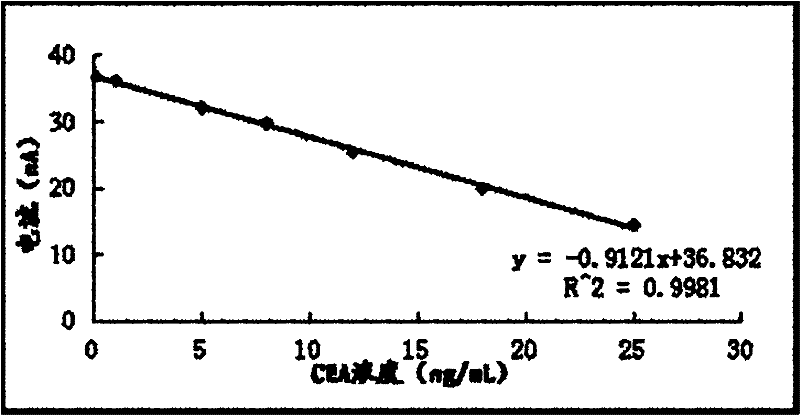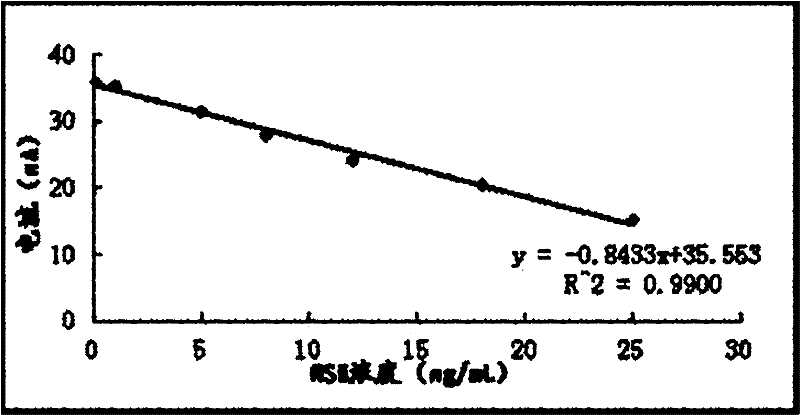Preparation method of molecularly imprinted polymer for detecting lung cancer tumor markers
A technology of tumor markers and molecular imprinting, which is applied in the fields of material chemistry and electrochemistry, can solve the problems of not reaching the protein level and relatively little research on protein molecular imprinting, and achieve convenient, rapid, effective, high specificity, and simple operation Effect
- Summary
- Abstract
- Description
- Claims
- Application Information
AI Technical Summary
Problems solved by technology
Method used
Image
Examples
Embodiment 1
[0036] Example 1 Molecularly imprinted polymers for detection of CEA
[0037] (1) Electrochemical modification of CEA
[0038] Take 4mg of ferrocene (FER) formate, dissolve in 800μL Na-HEPES buffer (0.15M, pH7.3), filter the solution through a 0.22μm microporous membrane, add 10mg (1-ethyl-3-[3- Dimethylaminopropylamine] carbodiimide-hydrochloric acid) (EDC) and 90 μL of 500 μ g / mL template molecule CEA and incubated at room temperature for 4 hours, ultrafiltration to remove unbound ferrocene formate until the filtrate no longer contains ferrocene formate. The prepared template complexes were stored at 4°C.
[0039] (2) Synthesis of molecularly imprinted polymers
[0040] The molecularly imprinted polymer is prepared by free radical polymerization induced by ultraviolet light. The template molecule is the template molecule obtained in (1), the functional monomer is ethyl dimethylol acrylate (EGDMA), the crosslinking agent is diacryloylpiperazine, the porogen is methanol, ...
Embodiment 2
[0043] Example 2 Molecularly imprinted polymer for detecting NSE
[0044] (1) Electrochemical modification of NSE
[0045] Take 4mg of ferrocene (FER) formate, dissolve in 800μL Na-HEPES buffer (0.15M, pH7.3), filter the solution through a 0.22μm microporous membrane, add 10mg (1-ethyl-3-[3- Dimethylaminopropylamine] carbodiimide-hydrochloric acid) (EDC) and 90 μL of 500 μ g / mL template molecule NSE and incubate at room temperature for 4 hours, and remove unbound ferrocene formate by ultrafiltration until the filtrate no longer contains ferrocene formate. The prepared template complexes were stored at 4°C.
[0046] (2) Synthesis of molecularly imprinted polymers
[0047] The molecularly imprinted polymer is prepared by free radical polymerization induced by ultraviolet light. The template molecule is the template molecule obtained in (1), the functional monomer is ethyl dimethylol acrylate (EGDMA), the crosslinking agent is diacryloylpiperazine, the porogen is methanol, a...
Embodiment 3
[0050] Example 3 Molecularly imprinted polymers for detection of CYFRA21-1
[0051] (1) Electrochemical modification of CYFRA21-1
[0052] Take 4mg of ferrocene (FER) formate, dissolve in 800μL Na-HEPES buffer (0.15M, pH7.3), filter the solution through a 0.22μm microporous membrane, add 10mg (1-ethyl-3-[3- Dimethylaminopropylamine] carbodiimide-hydrochloric acid) (EDC) and 90 μL of 500 μ g / mL template molecule CYFRA21-1 and incubated at room temperature for 4 hours, ultrafiltration to remove unbound ferrocene formate until the filtrate no longer contains ferrocene formate. The prepared template complexes were stored at 4°C.
[0053] (2) Synthesis of molecularly imprinted polymers
[0054] The molecularly imprinted polymer is prepared by free radical polymerization induced by ultraviolet light. The template molecule is the template molecule obtained in (1), the functional monomer is ethyl dimethylol acrylate (EGDMA), the crosslinking agent is diacryloylpiperazine, the por...
PUM
 Login to View More
Login to View More Abstract
Description
Claims
Application Information
 Login to View More
Login to View More - R&D
- Intellectual Property
- Life Sciences
- Materials
- Tech Scout
- Unparalleled Data Quality
- Higher Quality Content
- 60% Fewer Hallucinations
Browse by: Latest US Patents, China's latest patents, Technical Efficacy Thesaurus, Application Domain, Technology Topic, Popular Technical Reports.
© 2025 PatSnap. All rights reserved.Legal|Privacy policy|Modern Slavery Act Transparency Statement|Sitemap|About US| Contact US: help@patsnap.com



